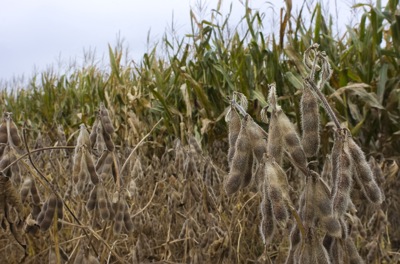Friday, October 14th, 2011
Local crops better than expected
Yields still likely below average for Mercer, Auglaize county farmers
By Nancy Allen

Photo by Mark Pummell/The Daily Standard
Rows of soybeans stand in front of a field of corn Thursday morning in Mercer County. Adverse weather conditions throughout the growing season have officials expecting lower yields for both grains.
Farmers are having a better than expected harvest despite challenges this growing season, but less than average yields are anticipated.
Crops have been hurt by a trifecta of poor conditions - a rainy spring which delayed planting by a month, and a hot, dry summer which hampered growth, followed by a cool, wet September.
In Mercer County, about 30 percent of the soybeans have been harvested and 15 percent of corn in the form of silage and high moisture corn for grain is off. In Auglaize County, about 35 percent of soybeans and 10 percent of the corn for grain is off, ag officials from both counties said.
"Overall, it's going to be a below average yield for Auglaize and Mercer counties because every day you're late planting, you expect some yield loss," said Anita Green, executive director of the Auglaize County Farm Service Agency (FSA).
Green said she's heard reports of corn yields ranging from 120 to 145 bushels (bu.) per acre with some more than that. Soybean yield reports are in the mid-30s to 40s.
Mercer County corn yield reports range from 110 to 180 bu. per acre and soybeans 40 to 60, said county FSA executive director Chris Gibbs. The average yield for corn and soybeans in both counties is about 148 and 50 bu. per acre respectively, USDA statistics show.
Vern Schroyer, operations manager at Mercer Landmark in Celina, said the elevator started taking soybeans last week ranging from 10 to 70 bu. per acre. No corn has come in, he said.
"It's all over the board," Schroyer said of soybean yields. "Some places got rains and some didn't. There was late planting and sporadic rainfall, heat and drought ... just all kinds of conditions."
Celina area farmer Dennis Eichenauer said his crops are the best he's had in awhile, but his land is in a pocket that seemed to miss timely rains the last three to four years.
Eichenauer said he's surprised by his soybeans.
"They're doing 50s and low 60s, which is just amazing to me with planting them in the middle of June and the dry July we had," he said. "I figured if we got 20 bushels per acre we were going to be lucky."
He attributed his yields to late rains and better seed varieties.
"The new hybrids are definitely helpful, but it still takes rain to get the better yields," he said.
Mercer County OSU Extension Educator Jim Hoorman said crops in the northern part of Mercer County fared better because of more rain. Areas south of Grand Lake, especially near Fort Recovery, got less rain and crops there weren't as good.
"I heard some reports up north where soybeans have done quite well, 60 to 70 bushels per acre," he sad. "Down here (near Celina) I'm hearing 45 to probably 50 to 60 bushels per acre."
Hoorman said he heard reports of 140 to 150 bu. per acre for some county corn.
Late rain didn't help corn, Hoorman said. Corn needs a lot of rain at pollination and it was done before the rains came, he said.
Hoorman said soybeans planted into cover crop fields were getting 10 bu. per acre better than conventionally farmed fields.
"The beans are much bigger, have a heavier test weight and are filled out better," he said of the cover crop bean fields. "We've not had enough corn come off cover crop fields to know what it has done."
Weather is still an issue. A hard freeze could zap soybean quality (it causes them to not ripen), and wind could cause already weakened corn stands to go down, Green said.
"Any winds or rain or snow would cause some real issues with corn standing," she said.
Farmers will spend more money this year on drying costs because the grain has a higher moisture content. It's also likely less wheat will be planted because it's taking longer to get off beans, local ag officials say.
A record runup in farm market prices U.S. farmers are paid for their crops the past three years has helped farmers' pocketbooks, but a loss in profits is never good, Gibbs said.
"We've taken over $1.50 out of corn in the last couple of weeks and nearly $2 from soybeans and that's all profit and the price of propane (for drying) remains the same," he said.
Local officials point to weather-resistant seed varieties as the biggest reasons this year's crops are better than expected.
"All the research that's gone into corn and soybeans in the last 30 years has paid off when you have the wide swings in weather events we have had this year," Gibbs said. "Soybeans planted the first week of June that make over 50 bushels per acre is just a gift."



